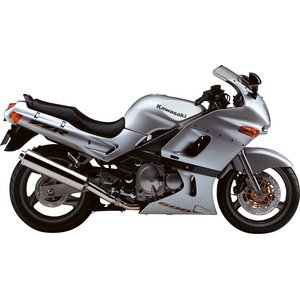Kawasaki ZZ-R 600 (1993-1996): The Sport-Touring Icon That Redefined Versatility
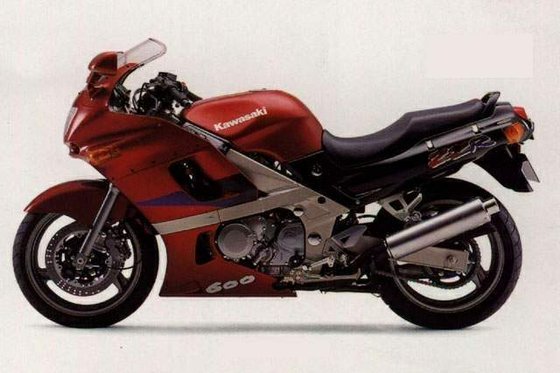
Introduction
When Kawasaki unleashed the ZZ-R 600 in 1993, it wasn’t just another middleweight sportbike—it was a statement. Bridging the gap between razor-sharp sportbikes and mile-eating tourers, the ZZ-R 600 carved out a niche as a "sport-touring" machine long before the term became mainstream. For riders who demanded adrenaline without sacrificing practicality, this bike became an instant classic. Three decades later, its legacy endures, and after a spirited test ride, it’s easy to see why. From its howling inline-four engine to its surprisingly forgiving ergonomics, the ZZ-R 600 remains a masterclass in balanced performance. Let’s dive into what makes this ’90s icon tick.
Design & Ergonomics: Form Meets Function
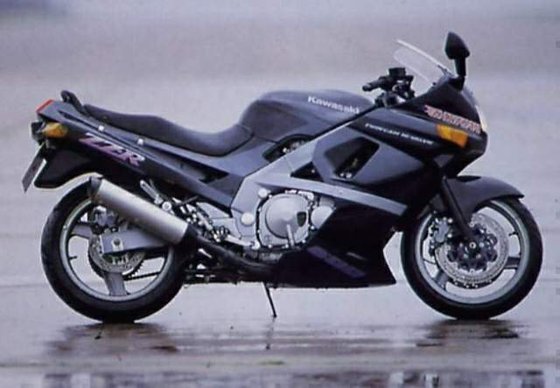
The ZZ-R 600’s design screams purpose. Its aerodynamic full fairing—complete with integrated mirrors and a ram-air intake—hints at its need for speed, while the aluminum twin-spar frame (a rarity in 600cc bikes of the era) promises agility. At 780 mm (30.7 inches), the seat height is approachable for riders of all statures, and the stepped two-up seat offers surprising comfort for long hauls.
Kawasaki’s attention to practicality shines through: a centerstand tucked beneath the twin exhausts simplifies chain maintenance, while the 18-liter (4.7-gallon) fuel tank ensures fewer pit stops. The analog-digital dash includes a fuel gauge and clock—luxuries often omitted from pure sportbikes. That said, the narrow handlebars feel dated compared to modern wide-set clip-ons, requiring a slight lean forward that’s sporty without being punishing.
Engine & Performance: The Heart of a Wolf in Sheep’s Clothing
At the core of the ZZ-R 600 lies a 599cc liquid-cooled inline-four engine, churning out 100 HP (73 kW) at 11,500 RPM and 62.8 Nm (46.3 lb-ft) of torque at 9,500 RPM. These numbers might seem modest by today’s standards, but in the early ’90s, this was borderline revolutionary.
Twist the throttle, and the carbureted beast awakens with a metallic snarl. Below 7,000 RPM, power delivery is smooth and tractable—perfect for city commutes. But hold the gears, and the real magic happens past 9,000 RPM. The engine transforms into a frenetic, wailing animal, pulling relentlessly to its 12,500 RPM redline. The six-speed gearbox slots cleanly, though the clutch requires a firm hand in stop-and-go traffic.
Ram-air induction, borrowed from Kawasaki’s race tech, gives a noticeable boost at triple-digit speeds. Stability remains rock-solid even at its claimed 246.9 km/h (153.4 mph) top speed, though the mirrors start vibrating ominously beyond 180 km/h (112 mph).
On the Road: Jack of All Trades, Master of Many
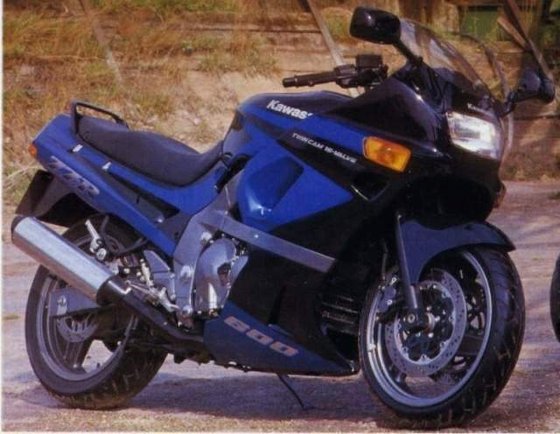
City Riding
The ZZ-R 600’s 195 kg (430 lbs) dry weight feels manageable at low speeds, though the narrow bars demand careful U-turns. The upright riding position minimizes wrist strain, and the torquey low-end lets you short-shift without bogging down. However, the soft suspension (41mm front forks with preload and rebound adjustment) wallows over potholes, a reminder that this bike prioritizes comfort over track-day sharpness.
Highway & Long-Distance
Crack open the throttle on an open highway, and the ZZ-R 600 truly comes alive. The fairing deflects windblast effectively, and the seat—while firm—supports all-day rides. At a steady 120 km/h (75 mph), the engine purrs at 7,000 RPM in sixth gear, returning an impressive 18.5 km/l (43.5 MPG). That’s enough for nearly 330 km (205 miles) per tank—a touring blessing.
Twisties & Backroads
Push hard into a corner, and the ZZ-R reveals its age. The Bridgestone BT50 tires (120/60 front, 160/60 rear) lack the grip of modern rubber, and the soft suspension dives under heavy braking. Yet, the chassis feels planted mid-corner, and the dual 300mm front discs (with four-piston calipers) deliver strong, if slightly wooden, stopping power. Ground clearance is ample for spirited riding, though dragging pegs is inevitable on track days.
Competition: How the ZZ-R 600 Stacks Up
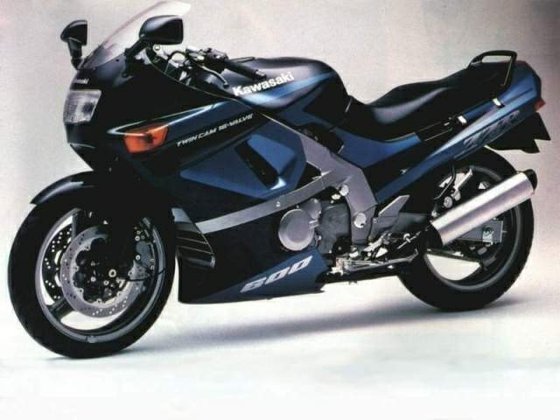
In the ’90s, the ZZ-R 600 faced fierce rivals. Here’s how it measured up:
1. Yamaha YZF600R (1994-1997)
- Pros: Sharper handling, better suspension, and a torquier mid-range.
- Cons: No fuel gauge, harder seat, and a peakier powerband.
- Verdict: The YZF600R edged ahead on technical roads but couldn’t match the ZZ-R’s touring comfort.
2. Honda CBR600F2 (1991-1994)
- Pros: Lighter, more agile, and legendary reliability.
- Cons: Less peak power, no ram air, and barebones ergonomics.
- Verdict: The CBR600F2 was the purer sportbike, but the ZZ-R offered a more versatile package.
3. Suzuki GSX-R600 (1992-1996)
- Pros: Race-bred DNA, sharper brakes, and aggressive styling.
- Cons: Harsher ride, cramped ergonomics, and shorter fuel range.
- Verdict: The GSX-R ruled the track, but the ZZ-R was the better daily companion.
Maintenance: Keeping the Legend Alive
Owning a ZZ-R 600 today means embracing its quirks. Here’s what to watch—and how MOTOPARTS.store can help:
1. Suspension Upgrades
The stock suspension, while plush, struggles with aggressive riding. Consider:
- Cartridge Emulator Kits: Sharpen front fork response.
- Adjustable Rear Shocks: Improve damping control for loaded touring.
2. Brake Overhaul
- Sintered Brake Pads: Reduce fade during spirited rides.
- Stainless Steel Brake Lines: Improve lever feel and consistency.
3. Carburetor TLC
The Keihin CVKD36 carbs demand regular cleaning. Stock up on:
- Carb Rebuild Kits: Replace worn jets and seals.
- Air Filters: High-flow options unlock hidden mid-range punch.
4. Chain & Sprockets
The 16/48 sprocket combo favors acceleration. For highway cruising, swap to a 15-tooth front sprocket (+2% top speed). Pair with a 520-chain conversion kit for reduced weight.
5. Cooling System
- High-Performance Coolant: Prevent overheating in summer traffic.
- Radiator Guards: Protect against road debris.
Conclusion: A Timeless All-Rounder
The Kawasaki ZZ-R 600 isn’t just a relic of the ’90s—it’s a testament to balanced engineering. Few bikes from its era can match its blend of spine-tingling performance, everyday usability, and bulletproof reliability. Sure, modern middleweights outgun it in specs, but none offer the same visceral connection or mechanical simplicity.
Whether you’re hunting for a weekend canyon carver, a commuter with charisma, or a project bike ripe for customization, the ZZ-R 600 delivers. And when it’s time to upgrade or refresh your ride, MOTOPARTS.store has the expertise and parts to keep this legend thundering down the road.
Ready to make your ZZ-R 600 sing again? Explore our curated selection of performance parts, tools, and accessories tailored for Kawasaki’s golden-era icon.
Specifications sheet
| Engine | |
|---|---|
| Stroke: | Four-stroke |
| Max power: | 73 kW | 98.0 hp |
| Max torque: | 64 Nm |
| Fuel system: | 4x Keihin CVKD36 carburetors |
| Max power @: | 11500 rpm |
| Displacement: | 599 ccm |
| Max torque @: | 9500 rpm |
| Configuration: | Inline |
| Cooling system: | Liquid cooled |
| Compression ratio: | 12.0:1 |
| Number of cylinders: | 4 |
| Valves per cylinder: | 4 |
| Dimensions | |
|---|---|
| Wheelbase: | 1399 mm (55.1 in) |
| Dry weight: | 198 |
| Wet weight: | 216 |
| Seat height: | 780 mm (30.7 in) |
| Overall width: | 728 mm (28.7 in) |
| Overall height: | 1176 mm (46.3 in) |
| Overall length: | 2029 mm (79.9 in) |
| Fuel tank capacity: | 18 L (4.7 US gal) |
| Drivetrain | |
|---|---|
| Final drive: | chain |
| Chain length: | 112 |
| Transmission: | 6-speed |
| Rear sprocket: | 48 |
| Front sprocket: | 16 |
| Maintenance | |
|---|---|
| Rear tire: | 160/60 z-17 |
| Engine oil: | 10W40 |
| Front tire: | 120/60 z-17 |
| Brake fluid: | DOT 4 |
| Spark plugs: | NGK CR9E or NGK CR9EIX |
| Spark plug gap: | 0.8 |
| Coolant capacity: | 2.5 |
| Forks oil capacity: | 0.858 |
| Engine oil capacity: | 3.5 |
| Engine oil change interval: | Every 5000km or 2 years, whichever comes first |
| Valve clearance (intake, cold): | 0.15–0.24 mm |
| Valve clearance check interval: | 24,000 km / 15,000 mi |
| Valve clearance (exhaust, cold): | 0.22–0.30 mm |
| Recommended tire pressure (rear): | 2.9 bar (42 psi) |
| Recommended tire pressure (front): | 2.5 bar (36 psi) |
| Chassis and Suspension | |
|---|---|
| Frame: | Aluminum twin-spar perimeter |
| Rear tire: | 160/60 z-17 |
| Front tire: | 120/60 z-17 |
| Rear brakes: | Single 240mm disc, 1-piston caliper |
| Front brakes: | Dual 300mm discs, 4-piston calipers |
| Rear suspension: | UNI-TRAC monoshock, preload and rebound damping adjustable |
| Front suspension: | 41mm hydraulic fork, preload and rebound damping adjustable |



